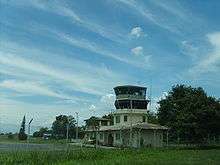Heriberto Gíl Martínez Airport
| Heriberto Gil Martínez Airport Aeropuerto Heriberto Gil Martínez | |||||||||||
|---|---|---|---|---|---|---|---|---|---|---|---|
 | |||||||||||
| IATA: ULQ – ICAO: SKUL | |||||||||||
| Summary | |||||||||||
| Airport type | Public | ||||||||||
| Owner | Tuluá | ||||||||||
| Operator | Marco Fidel Suarez Military Aviation School EMAVI | ||||||||||
| Serves | Cities and towns of the Middle Cauca Valley, Colombia | ||||||||||
| Location | Nariño Township, Tuluá, Colombia | ||||||||||
| Elevation AMSL | 3,132 ft / 955 m | ||||||||||
| Coordinates | 04°05′40.21″N 76°13′26.16″W / 4.0945028°N 76.2239333°W | ||||||||||
| Website | http://www.tulua.gov.co/otrasentidades.shtml?apc=o1I1--&x=1481093 | ||||||||||
| Runways | |||||||||||
| |||||||||||
| Statistics (2006–2008) | |||||||||||
| |||||||||||
The Heriberto Gil Martínez Airport is an airport located in the municipality of Tulua in the department of Valle del Cauca, Colombia.
Before 2004 its name was Farfan Airport, a name it received because of a pre-Hispanic settlement in the area of which there is a myth that tells the story of an tribe called Farfan but no corroborating documents. The Agreement No. 16, dated 20 August 2004, emanated from the Municipal Council (council), was renamed Heriberto Gil Martínez Airport, tulueño illustrious who was one of the first aviators Colombia's history, along with Camilo Daza presursor of aviation in Colombia and cofounder of the FAC.
Although an active commercial airport, it has no commercial air services. Currently the airstrip is used by the Marco Fidel Suárez Military Aviation School (EMAVI) de Santiago de Cali.
Although the air terminal is found throughout the middle of one of the most productive runners in Southwestern Colombia and in general in this country, the lack of interest of some sectors that have hindered the implementation of relevant literature, as one of the reasons that it has complicated the operationalization is the length of the runway because the aircraft can land there are too small and made it difficult for operating costs for such aircraft, which will decrease competitiveness.
See also
References
External links
- Plan Maestro del aeropuerto Heriberto Gil Martínez avanza satisfactoriamente Mayo 20 de 2009 11:36:46 am
- Group dedicated to Heriberto Martínez Gil Airport on Facebook
